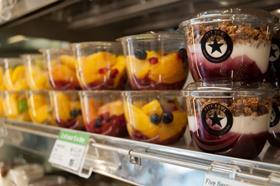
Increased consumption of food to go is eating into spending on household food, according to new findings by shopper insight specialistsShoppercentric.
The research in the analyst’s 50thShopper Trends report shows that four in five UK shoppers have eaten a meal that wasn’t prepared at home in the last month.
Meanwhile, one in ten believes their spending on household food, including fruit and veg, has reduced as a direct result of their ‘food-to-go’ spending habits.
The data confirms that Millennials and Generation Z shoppers are at the heart of the trend and are doing so more often than they were two years ago.
Some 44 per cent of the 25-34 age group said they had had food delivered to their home or office in the last month by the likes of Deliveroo, UberEats or Dominos, compared with 33 per cent of the 35-44 age group and just 25 per cent of the 45-54 age group.
The trend is growing with almost a fifth of respondents (19 per cent) saying they were having food delivered “way more” than two years ago and a quarter (25 per cent) “a little more” than two years ago.
When asked if they had bought food to eat on the go in a coffee shop or sandwich shop, 60 per cent of 18-24 year olds and58 per cent of 25-34 year olds had, compared with less than a third of the 55-64 age group and only 27 per cent of over-65s.
One in 10 shoppers believe their household food spending has reduced as a direct result of their ‘food-to-go’ spending habits.
Younger shoppers form the demographic group most likely to say the growth in the ‘food-to-go’ sector means they are spending less on groceries for home, with 22 per cent of 18-24 year olds and 15 per cent of 25-34 year olds agreeing they are spending less compared with just nine per cent of 35-44 year olds, five per cent of 45-54 year olds, six per cent of 55-64s and five per cent of over-65s.
“The research shows us that widening choice, easy accessibility, and pricing to cater for all tastes and budgets, means that many shoppers relying on ‘food-to-go’ believe their spending in those outlets will increase, which likely means more pressure on grocery spending,” said Shoppercentric’s managing director Jamie Rayner.
“Perhaps most worryingly for already under-pressure grocery retailers is that cash-rich Millennials, and Gen Z, are at the heart of this trend. They are the age groups who are most likely to have eaten food when out, or that was prepared away from the home.
'They are doing this more often and they are the ones most likely to say food to go is causing them to spend less on groceries.”
Rayner says there remains, of course, the possibility that these younger shoppers will turn into more budget-conscious, cook-at-home parents as they get older, though he doubts food to go really is a passing phase. Habits are forming.
“The fact that the food-to-go category is embracing healthier options and sustainability more quickly than grocery retailers means that no one in the grocery sector can afford to turn a blind eye to this challenge,” he said.
“For the supermarkets, food to go is a competitor hiding in plain sight and presents a growing challenge to which they need to rise.”



